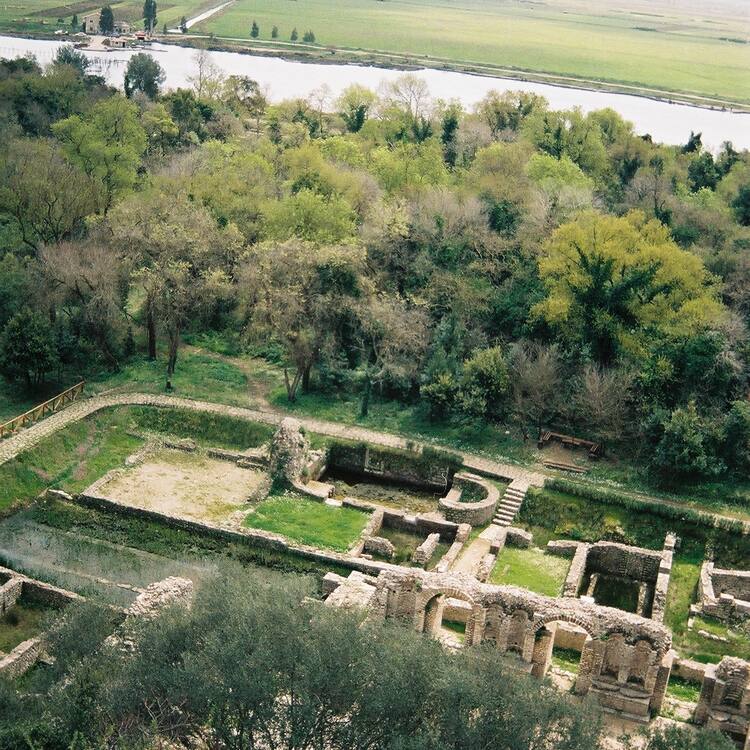Butrint
Butrint
Inhabited since prehistoric times, Butrint has been the site of a Greek colony, a Roman city and a bishopric. Following a period of prosperity under Byzantine administration, then a brief occupation by the Venetians, the city was abandoned in the late Middle Ages after marshes formed in the area. The present archaeological site is a repository of ruins representing each period in the city’s development.
Description is available under license CC-BY-SA IGO 3.0
Butrint
Habité depuis les temps préhistoriques, le site de Butrint fut successivement le siège d’une colonie grecque, d’une ville romaine, puis d’un évêché. Après une époque de prospérité sous l’administration de Byzance, puis une brève occupation vénitienne, la ville fut abandonnée par sa population à la fin du Moyen Âge à cause de la présence de marécages voisins. Le site archéologique actuel est un conservatoire des ruines représentatives de chaque période du développement de la ville.
Description is available under license CC-BY-SA IGO 3.0
بوترنت
إن موقع بوترنت الذي عرف استقراراً بشرياً منذ أيام ما قبل التاريخ كان على التوالي مقراً لمستوطنة إغريقية ومن ثم بلدة رومانية ومن بعدها مطرانية. وبعد فترة ازدهار تحت إدارة بيزنطيا تبعه احتلال بندقي قصير الأمد للمنطقة، هجر السكان المدينة في نهاية القرون الوسطى بسبب وجود مستنقعات قريبة. إن الموقع الأثري الحالي هو مجمع آثار تتمثّل فيه كلّ حقبة من حقبات تطوّر المدينة.
source: UNESCO/CPE
Description is available under license CC-BY-SA IGO 3.0
布特林特
布特林特城史前就有人定居,先后为希腊殖民地、古罗马城市和主教辖区所在地。在拜占庭时期,这里曾一度非常繁荣,后被威尼斯人短期占领。中世纪后期,由于该地区变成了沼泽,所以这个城市便被遗弃了。现在的考古遗址其实就是一个废墟,展现了这个城市发展各个时期的风貌。
source: UNESCO/CPE
Description is available under license CC-BY-SA IGO 3.0
Древний город Бутринт
Бутринт был местом древнегреческой колонии, древнеримским городом и центром епископства. Вслед за периодом процветания времен Византийской империи и краткой венецианской оккупации, в позднем средневековье город был заброшен, а территория заболочена. В настоящее время это - памятник археологии, где можно увидеть руины, отражающие каждый исторический период развития города.
source: UNESCO/CPE
Description is available under license CC-BY-SA IGO 3.0
Butrinto
Habitado desde tiempos prehistóricos, el sitio de Butrinto fue sucesivamente colonia griega, ciudad romana y sede de un obispado. Tras un período de prosperidad bajo la dominación de Bizancio y una breve ocupación de Venecia, la ciudad fue abandonada a fines de la Edad Media debido a la formación de tierras pantanosas en sus alrededores. Hoy en día, es un sitio arqueológico donde se pueden contemplar ruinas representativas de de cada una de las etapas de su historia.
source: UNESCO/CPE
Description is available under license CC-BY-SA IGO 3.0
ブトリント
アルバニア南部、サランダ県。現在の考古遺跡は、古代ギリシア・ローマ植民都市時代、初期キリスト教、ビザンチン支配下などのそれぞれの時代の様相を物語る宝庫である。中世紀末に湿地化したため、ブトリントの住民はこの地を去った。1997年初めの市民暴動によって遺構の略奪が行われ、遺跡の保護と管理が困難となったため、1997年危機遺産リストに登録された。今回ヴァロナ~ニコポリス間のローマ道、城壁地帯、ローマ時代の郊外、旧石器時代遺跡など8件が拡大登録された。source: NFUAJ
Butrint
Butrint maakt deel uit van het oude Albanese cultuurlandschap en werd bewoond sinds de prehistorie. Het was respectievelijk een Griekse kolonie, Romeinse stad en een bisdom. Butrint vormde een belangrijke stopplaats op handelsroutes. Onder Byzantijns gezag kende de stad een tijd van voorspoed. Later volgde een korte bezetting door de Venetianen en uiteindelijk verlieten de inwoners de stad in de Late Middeleeuwen, nadat er moerassen ontstonden in het gebied. De huidige archeologische plek is een verzameling van ruines die de verschillende periodes weerspiegelen. Zo vind je er een amfitheater, maar ook restanten van een viaduct en verschillende basilieken.
Source: unesco.nl
Outstanding Universal Value
Brief synthesis
Butrint, located in the south of Albania approximately 20km from the modern city of Saranda, has a special atmosphere created by a combination of archaeology, monuments and nature in the Mediterranean. With its hinterland it constitutes an exceptional cultural landscape, which has developed organically over many centuries. Butrint has escaped aggressive development of the type that has reduced the heritage value of most historic landscapes in the Mediterranean region. It constitutes a very rare combination of archaeology and nature. The property is a microcosm of Mediterranean history, with occupation dating from 50 000 BC, at its earliest evidence, up to the 19th century AD. Prehistoric sites have been identified within the nucleus of Butrint, the small hill surrounded by the waters of Lake Butrint and Vivari Channel, as well as in its wider territory. From 800 BC until the arrival of the Romans, Butrint was influenced by Greek culture, bearing elements of a “polis” and being settled by Chaonian tribes. In 44 BC Butrint became a Roman colony and expanded considerably on reclaimed marshland, primarily to the south across the Vivari Channel, where an aqueduct was built. In the 5th century AD Butrint became an Episcopal centre; it was fortified and substantial early Christian structures were built. After a period of abandonment, Butrint was reconstructed under Byzantine control in the 9th century. Butrint and its territory came under Angevin and then Venetian control in the 14th century. Several attacks by despots of Epirus and then later by Ottomans led to the strengthening and extension of the defensive works of Butrint. At the beginning of the 19th century, a new fortress was added to the defensive system of Butrint at the mouth of the Vivari Channel. It was built by Ali Pasha, an Albanian Ottoman ruler who controlled Butrint and the area until its final abandonment.
The fortifications bear testimony to the different stages of their construction from the time of the Greek colony until the Middle Ages. The most interesting ancient Greek monument is the theatre which is fairly well preserved. The major ruin from the paleo-Christian era is the baptistery, an ancient Roman monument adapted to the cultural needs of Christianity. Its floor has a beautiful mosaic decoration. The paleo-Christian basilica was rebuilt in the 9th century and the ruins are sufficiently well preserved to permit analysis of the structure (three naves with a transept and an exterior polygonal apse).
Criterion (iii): The evolution of the natural environment of Butrint led to the abandonment of the city at the end of the Middle Ages, with the result that this archaeological site provides valuable evidence of ancient and medieval civilizations on the territory of modern Albania.
Integrity
The property is of sufficient size (200 ha) to include a significant proportion of the attributes which express its Outstanding Universal Value. The buried archaeological sites, standing ruins and historic buildings are sufficiently intact. While the World Heritage property Butrint does not suffer significantly from adverse effects of development or neglect, there are vulnerabilities, such as increases in seasonal water levels, the need for better coordination of conservation works and archaeological excavations, vegetation growth, and structural instability of some monuments. There are also some pressures from modern development, including roads and urban expansion around the property. Nonetheless, Butrint still is an excellent case of preservation of ancient and medieval urban occupation. The surrounding landscape provides the context for the past urban change at Butrint.
Authenticity
The authenticity of the World Heritage property Butrint is related to its excellent preservation on a site where the changing human interaction with the environment can be observed in the surviving monuments, the below-ground archaeology and the surrounding landscape. The quality of the restoration and conservation work carried out since 1924 has been high. Later interventions have abided by contemporary standards as set out in the 1964 Venice Charter.
Protection and management requirements
Butrint National Park was inscribed on the National Heritage List of Protected Monuments in 1948. Currently, the protection and conservation of the archeological monuments is covered by the Law on Cultural Heritage. The natural values of the Butrint Wetlands were recognized by the Ramsar Convention in 2002. In 2005, based on the Law on Protected Areas, Butrint was declared a National Park covering 86 km². The National Park acts as a buffer zone for the World Heritage property. The National Park, which has a Board chaired by the Minister of Culture and professional staff, is responsible for the management of the World Heritage property. The national Institute of Cultural Monuments and the Institute of Archaeology are responsible for all research, excavations and consolidation of architectural and archaeological remains.
Butrint manifests several vulnerable aspects. Potentially these vulnerabilities could threaten the integrity of the property in the long term. To avoid threats to integrity and authenticity, monitoring and controlling the vulnerabilities are crucial issues in the Management Plan of Butrint on Archaeology and Monuments. The Management Plan must be harmonized with other plans covering the property and the National Park.

 View photos from OUR PLACE the World Heritage collection
View photos from OUR PLACE the World Heritage collection